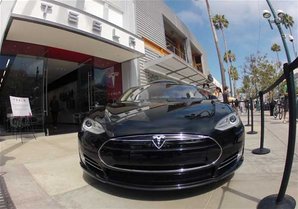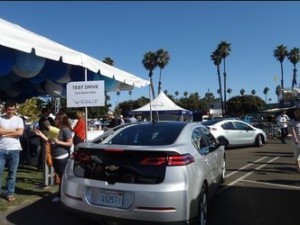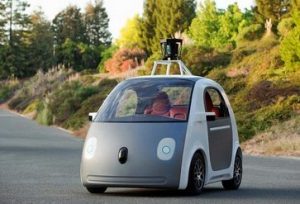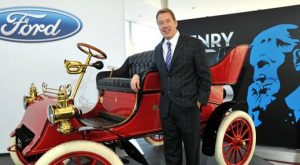by Jon LeSage, editor and publisher, Green Auto Market
Here’s my take on the 10 most significant and interesting occurrences during the past week…….
 EV sales in April: The Tesla Model S secured its top spot in front of the Nissan Leaf for the month of April – 1,900 for the Model S versus 1,553 for the Leaf (according to HybridCars.com and Baum & Associates). For 2015, the Model S is leading US the electric vehicle (EV) segment – with 6,800 units sold compared to No. 2 Leaf at 5,638 sold this year. The Leaf is still leading the pack as the highest-selling EV ever – nearing almost 78,000 in the US and expected to cross the 200,000 mark in global sales sometime this summer. The Chevrolet Volt saw 905 units in April, its highest monthly total since last December. There were a few surprises in the top 10 in April EV sales – one of them being the best-selling month for the Chevrolet Spark EV at 920 units sold. The Ford C-Max Energi also saw a big increase on the list, and the BMW i3 saw its first sales drop since entering the US market.
EV sales in April: The Tesla Model S secured its top spot in front of the Nissan Leaf for the month of April – 1,900 for the Model S versus 1,553 for the Leaf (according to HybridCars.com and Baum & Associates). For 2015, the Model S is leading US the electric vehicle (EV) segment – with 6,800 units sold compared to No. 2 Leaf at 5,638 sold this year. The Leaf is still leading the pack as the highest-selling EV ever – nearing almost 78,000 in the US and expected to cross the 200,000 mark in global sales sometime this summer. The Chevrolet Volt saw 905 units in April, its highest monthly total since last December. There were a few surprises in the top 10 in April EV sales – one of them being the best-selling month for the Chevrolet Spark EV at 920 units sold. The Ford C-Max Energi also saw a big increase on the list, and the BMW i3 saw its first sales drop since entering the US market.- Autonomous vehicles take over SAE World Congress: Automakers are running the gamut on self-driving cars – similar to alternative fuel vehicles. No one technology is winning but several are being considered. “There are many schools of thought and many concepts being tried,” said Cadillac spokesman David Caldwell, during the annual SAE World Congress in Detroit. German automakers have been taking the lead – including BMW unveiling the i3 hybrid version equipped with Traffic Jam Assistant two years ago, which allows the vehicle to accelerate, brake and steer at speeds up to 25 mph. Keynote speaker Ray Kurzweil, director of engineering at Google and a recognized futurist, says that the days are approaching when an inexpensive computer outperforms a human at a task such as driving; reasons for self-driving cars moving forward include their role in drastically reducing road fatalities and freeing people up to do something useful during their dreaded commuter trips.
- Demand strong for CNG/propane F-150: Ford Motor Co. says the 2016 F-150 pickup will be available with a 5.0-liter V8 engine that can run on compressed natural gas or propane. Ford says demand for these trucks has been steadily increasing for the past five years. Ford sold a record 16,821 commercial/fleet vehicles with CNG/propane gaseous engine-prep packages in 2014, and the automaker thinks that 2015 will be even stronger. Customers have been asking for more trucks and vans that run on these alternative fuels because it lowers their fleet operating costs and reduces greenhouse gas emissions.
- Vouchers in Chicago: VIA Motors has gained an exclusive voucher program for Chicago area fleets and business owners. VIA says it will dramatically reduce the initial costs of owning a VIA Motors extended range pickup truck, extended range electric passenger van, or extended range electric cargo van. The extended range pickup is now eligible for a $41,200 voucher, the passenger van is eligible for a $39,460 voucher and the cargo van is eligible $42,892.
- Price coming down for Volt: The 2016 Chevrolet Volt will be priced from $33,995 when it goes on sale sometime this fall; the price, which includes delivery, is $1,175 lower than that of the outgoing 2015 Volt. The 2016 Volt also offers appealing features – extended range, out to 50 miles on the battery and a fifth “seating position” in the car. That will put the Volt more in line with average transaction prices of light vehicles sold in the US.
- Sources for utility power changing: The U.S. Energy Information Administration (EIA) expects that 91% of a forecasted 20 gigawatts (GW) in new generating capacity will come from wind, solar, and natural gas. By the end of 2015, EIA forecasts that 9.3 GW of new wind generating capacity, 6.3 GW of natural gas, and 2.2 GW of solar. Coal’s share of the electricity-generating load will continue to decrease.
- Toyota EVs in China: While Toyota has been shifting away from electric vehicles (EVs) in markets such as the US in favor of hydrogen fuel cell vehicles, the Chinese government would like to see a different approach adopted. China wants to see automakers roll out more EVs to meet its “new energy” targets. In joint ventures with Chinese partners Guangzhou Automobile Group and FAW Group, Toyota will introduce the Leahead and Ranz all-electric brands this year in that market. It’s probably for show to please the Chinese government, analysts say.
- Hybrid and EV commercial vehicles: Navigant Research predicts that global sales of electric drive and electric-assisted commercial vehicles will grow from less than 16,000 vehicles in 2014 to nearly 160,000 in 2013. The size and weight of battery packs in electric vehicles can limit usability for several fleets, but their products choices are becoming more versatile in the next few years for trucks, vans, and buses. Vehicles that qualify for these Navigant Research study categories fall under a broad definition. That includes hybrid vehicles used in commercial applications (medium-to-heavy duty); and niche applications for plug-in hybrid and battery electric vehicles that can use onboard electrical energy to replace idling diesel engines or provide temporary power to buildings or tools at remote sites.
- Wrightspeed launches turbine generator: Wrightspeed Inc., a manufacturer of range-extended electric vehicle powertrains, has launched the Fulcrum, a turbine generator and electric vehicle range extender. Utilizing a proprietary set of advancements, the Fulcrum’s design could represent a breakthrough that challenges today’s piston engines and existing turbine generators. Wrightspeed is hopeful that the 80 kilowatt Fulcrum turbine generator sets a new standard as the company works to evolve electric vehicle propulsion. Located in Silicon Valley, Wrightspeed was founded by Ian Wright, a co-founder of Tesla Motors back in its startup days.
- Tesla enters CPO market: Tesla Motors has launched a certified pre-owned (CPO) website page, but it might be a bit early in the process to see much inventory there. During a recent media conference call, Kelley Blue Book’s Alec Gutierrez said that with current monthly sales of the Model S in the 1,500 to 1,700 range, it’s still early in the remarketing process. It does make sense to get started now, though, he said. “They want to have enough certified pre-owned inventory out there to help give consumers something in between the Model 3, whenever that arrives, and the full blown Model S or Model X, when that arrives,” Gutierrez said. “So to me, it’s a good play, but a long-term strategy for sure.”






